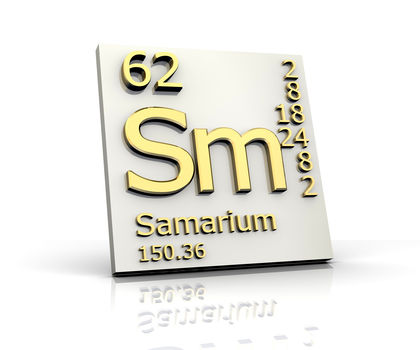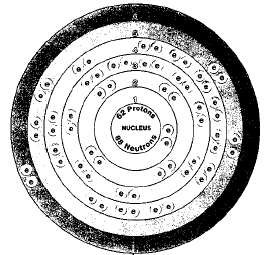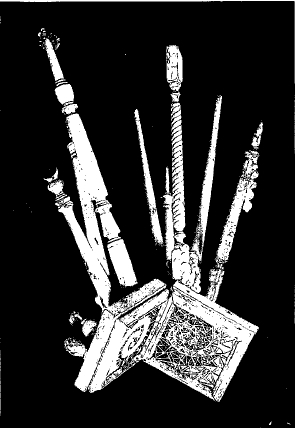SAMARIUM


Overview
Samarium is one of the rare earth elements found in Row 6 of the periodic table. The periodic table is a chart that shows how chemical elements are related to each other. The rare earth metals are not really very rare in the Earth's surface. The name comes from the fact that these elements are very difficult to separate from each other. For a long time, chemists knew very little about the individual elements. A more correct name for the rare earth elements is the lanthanide series. It is named after the element lanthanum, a transition metal also often considered a lanthanide.
Samarium looks and behaves like most other metals, but it has relatively few uses. One of the most important is in the manufacture of very powerful magnets. Compounds of samarium are also used to color glass and in television tubes.
SYMBOL
Sm
ATOMIC NUMBER
62
ATOMIC MASS
150.4
FAMILY
Lanthanide
(rare earth metal)
PRONUNCIATION
suh-MARE-ee-um
Discovery and naming
The study of chemical elements during the nineteenth century was frustrating. Each time a new element was announced, questions were immediately raised. Was the element really a new element? Or was it a mixture of two or more new elements?
The discovery of samarium grew out of this kind of frustration. In 1880, French chemist Paul-Émile Lecoq de Boisbaudran (1838-1912) was studying a substance known as didymium. Earlier chemists believed didymium might be a new element. Boisbaudran said that at least two new elements were present in didymium.
At nearly the same time, French chemist Jean-Charles-Galissard de Marignac (1817-94) was also studying didymium. He was able to separate didymium into two parts, which he called didymium and samarium. He announced that samarium was a new element.
Marignac's research appeared to be satisfactory for nearly twenty years. Then, another French chemist, Eugène-Anatole Demarçay (1852-1904), found that samarium could itself be broken into two parts. He called the new elements samarium and europium. Because of this long history, credit for the discovery of samarium is usually given to Boisbaudran, Marignac, Demarçay, or to all three chemists.
The name samarium was taken from a mineral in which it occurs, samarskite. The name of the mineral, in turn, comes from the last name of a Russian mine official, Colonel Samarski.
Physical properties
Samarium is a yellowish metal with a melting point of 1,072°C (1,962°F) and a boiling point of about 1,900°C (3,450°F). Its density is 7.53 grams per cubic centimeter. Samarium is the hardest and most brittle of the rare earth elements.
Chemical properties
Samarium is a fairly reactive metal. It tends to combine with many other substances under relatively mild conditions. For example, it reacts with water to release hydrogen gas. It also combines easily with oxygen and will ignite (catch fire) at about 150°C (300°F).
Occurrence in nature
As with other rare earth elements, the primary sources of samarium are the mineral monazite and bastnasite. It is also found in samarskite, cerite, orthite, ytterbite, and fluorspar.

Samarium is regarded as a relatively abundant lanthanide. It occurs to the extent of about 4.5 to 7 parts per million in the Earth's crust. That makes it about as common as boron and two other lanthanides, thulium and gadolinium.
Isotopes
There are seven naturally occurring isotopes of samarium, samarium-144, samarium-147, samarium-148, samarium-149, samarium-150, samarium-152, and samarium-154. Isotopes are two or more forms of an element. Isotopes differ from each other according to their mass number. The number written to the right of the element's name is the mass number. The mass number represents the number of protons plus neutrons in the nucleus of an atom of the element. The number of protons determines the element, but the number of neutrons in the atom of any one element can vary. Each variation is an isotope.
Three of samarium's naturally occurring isotopes are radioactive—samarium-147, samarium-148, and samarium-149. A radioactive isotope is one that breaks apart and gives off some form of radiation.
One radioactive isotope of samarium, samarium-153, is used in medicine. Patients with bone cancer often have very severe pain. The isotope samarium-153, can help relieve that pain. It in injected in the form of a drug known as Quadramet. Quadramet was approved by the U.S. Food and Drug Administration (FDA) for this purpose in March 1997.
Extraction
Samarium can be obtained by heating samarium oxide (Sm
2
O
3
) with
barium
or lanthanum metal:
Uses
Samarium has some uses similar to those of other rare earth elements. For example, it can be added to glass for color or special optical (light) properties. It is also used to make lasers for special applications. A laser is a device for producing very bright light of a single color. The color produced by the laser depends on the elements it contains.
One of the most important uses of samarium is in the manufacture of very powerful magnets. Samarium is combined with the metal cobalt to make samarium-cobalt, or SmCo, magnets. They are among the strongest magnets known. They also have other desirable properties. For example, they can be used at high temperatures and do not react easily with substances around them. SmCo magnets are widely used in motors, such as those used to power specialized kinds of airplanes.
Compounds
The only compound of samarium with any commercial applications is samarium oxide (Sm 2 O 3 ). This compound is used in the manufacture of special kinds of glass, as a catalyst in the manufacture of ethanol (ethyl alcohol), and in nuclear power plants as a neutron absorber.
Health effects
The health effects of samarium are not well studied. In such a case, chemists treat the element as toxic and handle it with great caution.